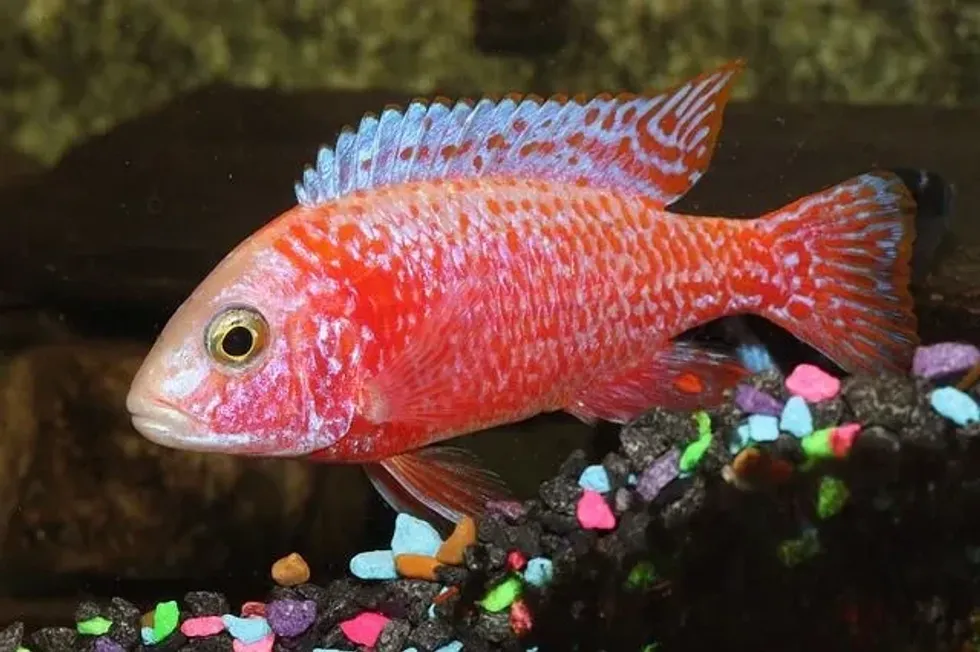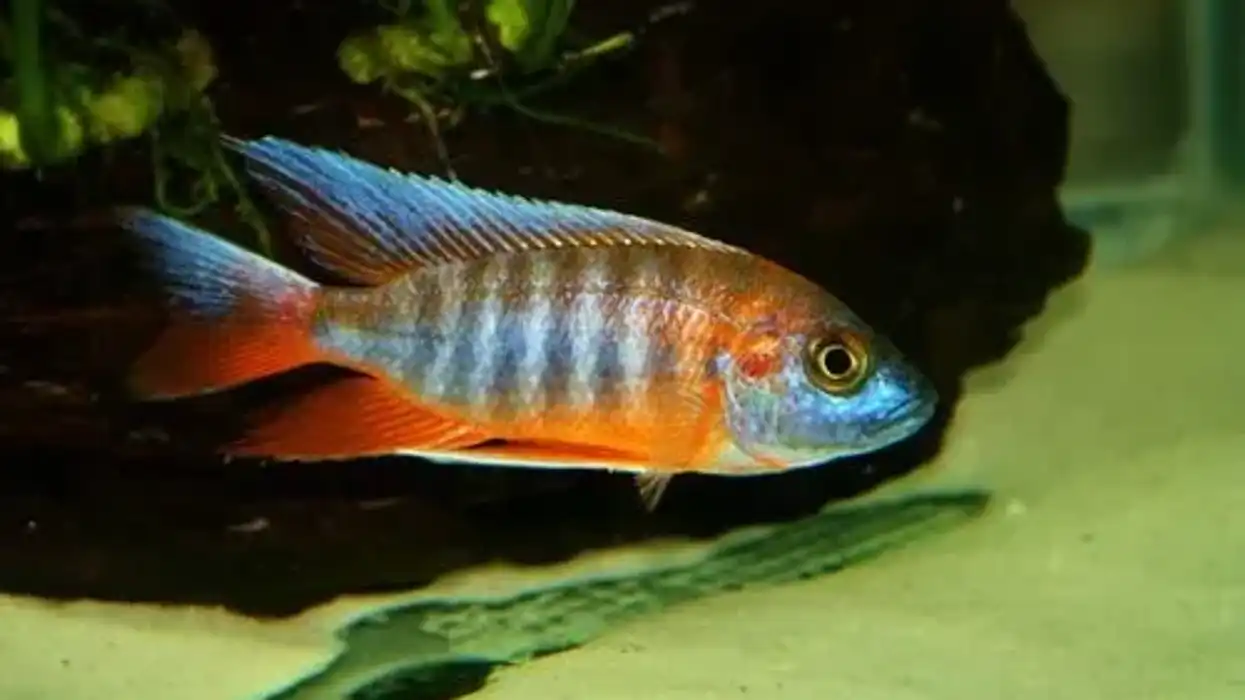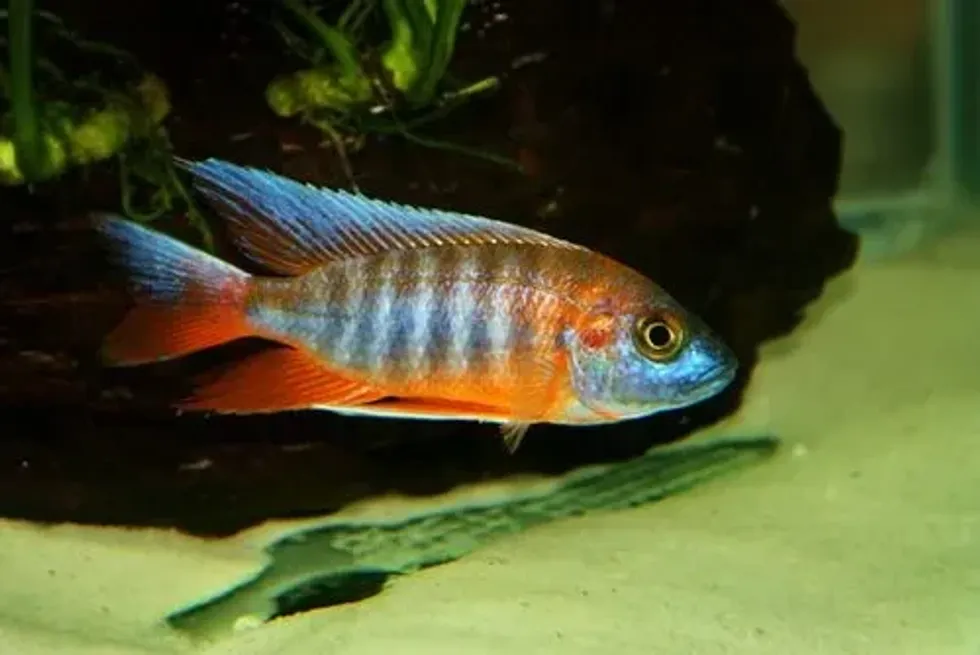Fun Peacock Cichlid Facts For Kids

Content
- What type of animal is a peacock cichlid?
- What class of animal does a peacock cichlid belong to?
- How many peacock cichlids are there in the world?
- Where does a peacock cichlid live?
- What is a peacock cichlid's habitat?
- Who do peacock cichlids live with?
- How long does a peacock cichlid live?
- How do they reproduce?
- What is their conservation status?
- What do peacock cichlids look like?
- How cute are they?
- How do they communicate?
- How big is a peacock cichlid?
- How fast can a peacock cichlid swim?
- How much does a peacock cichlid weigh?
- What are their male and female names of the species?
- What would you call a baby peacock cichlid?
- What do they eat?
- Are they dangerous?
- Would they make a good pet?
- Did you know...
- Can peacock cichlids live with other fish?
- How to tell if a peacock cichlid is male or female
The Astatotilapia family includes the peacock cichlid, a spectacular species of fish endemic to Lake Malawi. These peacocks come in at least 22 different varieties, with the bulk of them having spectacular colors.
They come in a range of shades, ranging from blues and reds to yellows, and can stand out in every aquarium. The blue (Aulonocara nyassae) peacock cichlid is the most common, and it will be the focus of this article.
Cichlids have a reputation for being hostile, but the peacock cichlid is relatively calm.
Males can be aggressive, but they are mostly peaceful and make good a group of fish. The peacock cichlid is a common freshwater fish that is popular among all fish enthusiasts and aquarium owners!
The peacock cichlid is a species of freshwater fish that includes the entire Aulonocara genus. These are one of the friendliest and most peaceful cichlids you can keep in your aquarium.
Peacock cichlids are found in Lake Malawi in eastern Africa, where they live near the bottom of the deep water, searching for food in the sandy substrate.
The peacock cichlid is a good swimmer who is constantly on the lookout for prey.
Peacock cichlids come in over 20 different varieties, and it's no surprise that almost all of them can be found in Lake Malawi, the world's ninth-largest lake!
Just a few species, such as the African butterfly peacock cichlid, the sunshine peacock cichlid, the flavescent peacock cichlid, the Nkhomo-benga peacock cichlid, the Aulonocara Fort Maguire cichlid, the Maulana bicolor peacock cichlid, and the Aulonocara blue gold cichlid, are commonly kept aquariums.
If you enjoyed our facts about the peacock cichlid, do go through our other articles on the colossal squid or the chum salmon.
Peacock Cichlid Interesting Facts
What type of animal is a peacock cichlid?
The only members of the genus Aulonocara are hundreds of species of fish, known as peacock cichlids.
What class of animal does a peacock cichlid belong to?
The peacock cichlid is a fish belonging to the Actinopterygii class.
How many peacock cichlids are there in the world?
Peacock cichlids come in 22 different varieties native to their largest lake: Lake Malawi. The name derives from the fish's vivid colors, which mimic the tail of a peacock. No census has been conducted to calculate their exact numbers around the globe but we do know that they are native to Lake Malawi.
Where does a peacock cichlid live?
As a diurnal visual predator, peacock cichlids have a particular preference for marine habitats with transparent water. Since it is euryhaline, it is found mainly in freshwater and they have a confirmed upper salinity tolerance of 18 ppt.
For the peacock cichlid, Aulonocara is their genus.
This is a tropical genus that is less cold tolerant than other cichlids imported to the United States. Cold winters narrow the distribution of peacock cichlid (Aulonocara genus) in Florida, limiting it to the southernmost counties and excluding it from much of the Everglades.
What is a peacock cichlid's habitat?
Peacock cichlids are found in Lake Malawi in eastern Africa, where they live near the bottom of the water, searching for food in the sandy substrate.
Who do peacock cichlids live with?
Typical peacock cichlid tank mates can be their own species as well as many other creatures, including hap cichlids.
Maintaining a ratio of one male to four females is the easiest way to hold the tank mates united. This will aid in the formation of schools inside the aquarium as males are solitary and possessive and may not get well along with other male tank mates.
They will typically choose a cave or other overhang as a location to attract fertile females, and males in a peacock cichlid tank will not be part of a school, while females will.
How long does a peacock cichlid live?
The age and lifespan of peacock cichlids depend entirely upon the species. Some species might live up to eight years of age, while some might exceed this, living to the age of 10. However, some peacock cichlids might die at the tender age of six.
How do they reproduce?
Breeding fish in captivity can be challenging, but peacock cichlids can be bred in captivity with the proper knowledge and climate. Peacock cichlids are an African cichlid species from Lake Malawi but they are also bred in captivity today.
These fish are brightly colored and non-aggressive, making them great pets. To successfully breed peacock cichlids, you'll need to set up a breeding tank and collect the fry in a tank away from the parents until the cichlids spawn.
Peacock cichlids are available for import in a number of species today and many are hybrids, meaning fish from two different subspecies are mated to create fish that you can buy.
These hybrid fish aren't able to reproduce. If you're serious about breeding peacock cichlids, make sure you buy fish specifically for that purpose, and then make sure you have enough tanks to hold all of the offspring.
Peacock cichlids, like all cichlid animals, are mouthbrooders. After the eggs are fertilized, the females take over this task.
Males begin by digging a shallow pit in front of their cave of origin and when a female of interest is close by, they splay their fins and show brighter colors. Males can also dart and participate in other activities to attract females.
When a female expresses a curiosity, the male will lead her to the pit he has dug.
This is where the female lays her eggs. The female takes the eggs into her mouth while the male fertilizes them and the female then holds the eggs in her mouth until they hatch to become fry and are ready to be released, which should take about 28 days.
What is their conservation status?
The IUCN has not investigated the conservation status of peacock cichlids. As a result, they are not on their Red List.
Peacock Cichlid Fun Facts
What do peacock cichlids look like?
If you've seen other cichlid species, you'll know that they're among the most vibrantly colored freshwater fish. Peacock cichlids are no exception.
They're some of the most vibrant fish you'll ever see, with hues ranging from blue and gold to green and purple.
The most common one you'll find in an aquarium is the blue one (Aulonocara nyassae). You'll also find that, rather than being matte, their paint is iridescent.
Their color is unusual and vibrant and one fun fact is that their color is not affected by their temperament or breeding status, as it is in other cichlids.
The different peacock cichlid types are all fundamentally the same fish, each with different coloring, which varies depending on the area of Lake Malawi from which each fish comes.
It's interesting to note that both juvenile cichlids and females are usually a drab grey color, so if you wish to add color to your water tank, it is recommended to buy a male.

How cute are they?
The aquarium fish species of peacock cichlids are truly adorable. The genus Aulonocara fish has gone through many hybrid breeding cycles, and the natural habitat of many of these species has now become a tank or an aquarium. Due to its attractive color and low price, it is in high demand among collectors and aquarium enthusiasts.
How do they communicate?
Most cichlids use innervation and hormones to express themselves, whether they are feeling aggressive, amorous, fearful, or maternal. They do this by changing their color patterns.
Bands and spots emerge and vanish according to their emotions, but this species' fundamental color pattern is species-specific and genetically defined.
So, since peacock cichlids do not change their colors based on their emotions, they tend to rely on their behavior itself to communicate. For example, they dig a hole to attract a female and use various other gestures and body language to communicate.
How big is a peacock cichlid?
A male peacock cichlid will grow to be about 4-6 in (10-15 cm) long in a home aquarium, while females will be slightly smaller. They are active swimmers who are three times bigger than a bee hummingbird.
How fast can a peacock cichlid swim?
Peacock cichlids are very active swimmers, but their speed has not been officially measured.
How much does a peacock cichlid weigh?
Peacock cichlids can weigh up to 29 lb (13 kg).
What are their male and female names of the species?
All male peacock cichlid and female peacock cichlid fish are referred to simply as peacock cichlid fish.
What would you call a baby peacock cichlid?
A 'fry' is a juvenile fish that has had its yolk sac fully absorbed. A fry can feed on its own and when a fry matures into an adult peacock cichlid, it will go through many more developmental stages.
What do they eat?
Cichlids are omnivores, which means they consume both meat and plants. They are bottom dwellers in the wild, which means they can sift across sandy substrates for food, insects, larvae, zooplankton, and other crustaceans.
This is something you can try to replicate in your aquarium. Begin by feeding them a high-quality cichlid pellet as the foundation of their diet, which you can then complement with meat and vegetables.
Brine shrimp (live or frozen) and daphnia (frozen) can be fed to adult peacock cichlids. Tubifex worms and all mammalian meat should be avoided because they can cause bloat.
It can also help to feed them flakes, as long as they are certified to be safe for cichlids. In terms of feeding duration, instead of a single big feeding, owners should feed them many smaller portions during the day.
Are they dangerous?
No, unlike African cichlids, this aquarium species is calm and not that aggressive.
Would they make a good pet?
The peacock cichlid is a very gentle and easy-to-keep cichlid, unlike African cichlids. They are a crowd favorite due to their beautiful coloration and engaging personalities.
The fact that these peacock cichlids are so stunning is one of the reasons they're so famous. Many other freshwater animals don't have the same bright hue as these fish.
Peacock cichlid care also doesn't involve as much work compared to other tank or aquarium fishes. The lower peacock cichlid care requirements, their vibrant color schemes, and their low cost make them one of many fan-favorite aquarium pets.
Did you know...
The peacock cichlid can eject sand from their gills when hunting in the substrate in a natural environment.
In a cichlid tank, overcrowding is a necessary evil. An aggressive fish will have a more challenging time picking out a single opponent in a crowded tank.
Infertile males have less vibrant coloration.
The water temperature of a peacock cichlid tank should be 72 F (22.2 C). The maximum water temperature of the tank can be up to 84 F (28.9 C) and no more.
There are many different types of peacock cichlids. The different types of peacock cichlids are famous for various reasons.
For example the flavescent peacock cichlid (Aulonocara stuartgranti), also called Grant's peacock, is a haplochromine cichlid species. It also includes the red peacock cichlid (Aulonocara stuartgranti). Red peacock cichlids are by far the most common peacock cichlids, and it's easy to see why.
These fish have a brilliant red hue that makes them stand out in an aquarium of other fish. They also have an interesting blue streak going through their fins.
The strawberry peacock cichlid is a beautiful fish. These fish are a vivid reddish-pink color, with several fins covered in interesting dots.
It can be challenging to select a genuine strawberry, so best of luck! The OB peacock cichlid has a body that is primarily red, with interesting dark blue spots all over. The markings on their face are lighter and extend to their caudal and dorsal fins.
finally, the Nkomo-Benga peacock cichlid (Aulonocara baenschi), also known as the new yellow regal peacock, is an endangered haplochromine cichlid of Lake Malawi. The aquarium trade sadly poses a threat to this species (Aulonocara baenschi).
Can peacock cichlids live with other fish?
Cichlids, in general, have a poor reputation for being violent, and this reputation is well-deserved. On the other hand, peacock cichlids are not like other cichlids; they are the 'tamer' members of the family and are usually much more peaceful.
The first step to preventing aggression is to ensure that any fish you keep with your peacock cichlids will live in the same water parameters. Many people select tank mates native to Lake Malawi for this purpose.
Many of the gentler Haps (Haplochromis) can be held with peacocks, such as Copadichromis, Placidochromis, Nyassachromis, and Sciaenochromis.
However, not all Lake Malawi cichlids are compatible with peacocks in an aquarium. They shouldn't be grouped with more active fish than themselves, such as the Petrotilapia, Labeotropheus, Pseudotropheus, and Mbuna.
How to tell if a peacock cichlid is male or female
Males and females in most peacock cichlid species are sexually dimorphic, which means that males and females look different. The most reliable method of deciphering cichlid gender is to examine the form of the fish's genital papilla, which is apparent at spawning time.
The difference in the size of these aquarium fish can also be a factor. Also, the males are generally more colorful.
Here at Kidadl, we have carefully created lots of interesting family-friendly animal facts for everyone to discover! Learn more about some other fish, including the tarpon, or the fluke fish.
You can even occupy yourself at home by drawing one on our peacock cichlid coloring pages.
We Want Your Photos!
More for You
Sources
https://www.aquariumsource.com/peacock-cichlid/
https://www.fishkeepingworld.com/peacock-cichlid/
https://en.wikipedia.org/wiki/Aulonocara
https://cichlidtips.com/peacock-cichlid-everything-you-need-to-know/
https://www.aquaticcommunity.com/cichlid/aulonocara2.php#
See All
Bachelor of Commerce specializing in Accounting and Finance, Master of Business Administration

Divya RaghavBachelor of Commerce specializing in Accounting and Finance, Master of Business Administration
With a diverse range of experience in finance, administration, and operations, Divya is a diligent worker known for her attention to detail. Born and raised in Bangalore, she completed her Bachelor's in Commerce from Christ University and is now pursuing an MBA at Narsee Monjee Institute of Management Studies, Bangalore. Along with her professional pursuits, Divya has a passion for baking, dancing, and writing content. She is also an avid animal lover who dedicates her time to volunteering for animal welfare causes.
Bachelor of Arts specializing in English Literature

Deeti GuptaBachelor of Arts specializing in English Literature
A detail-oriented fact-checker with a research-oriented approach. Devika has a passion for creative writing, she has been published on multiple digital publishing platforms and editorials before joining the Kidadl team. Currently pursuing a Bachelor of Arts in English Literature from St.Xavier's College, Deeti has won several accolades and writing competitions throughout her academic career.
Disclaimer
1) Kidadl is independent and to make our service free to you the reader we are supported by advertising. We hope you love our recommendations for products and services! What we suggest is selected independently by the Kidadl team. If you purchase using the Buy Now button we may earn a small commission. This does not influence our choices. Prices are correct and items are available at the time the article was published but we cannot guarantee that on the time of reading. Please note that Kidadl is a participant in the Amazon Services LLC Associates Program, an affiliate advertising program designed to provide a means for sites to earn advertising fees by advertising and linking to Amazon. We also link to other websites, but are not responsible for their content.
2) At Kidadl, we strive to recommend the very best activities and events. We will always aim to give you accurate information at the date of publication - however, information does change, so it’s important you do your own research, double-check and make the decision that is right for your family. We recognise that not all activities and ideas are appropriate for all children and families or in all circumstances. Our recommended activities are based on age but these are a guide. We recommend that these ideas are used as inspiration, that ideas are undertaken with appropriate adult supervision, and that each adult uses their own discretion and knowledge of their children to consider the safety and suitability. Kidadl cannot accept liability for the execution of these ideas, and parental supervision is advised at all times, as safety is paramount. Anyone using the information provided by Kidadl does so at their own risk and we can not accept liability if things go wrong.
3) Because we are an educational resource, we have quotes and facts about a range of historical and modern figures. We do not endorse the actions of or rhetoric of all the people included in these collections, but we think they are important for growing minds to learn about under the guidance of parents or guardians.







